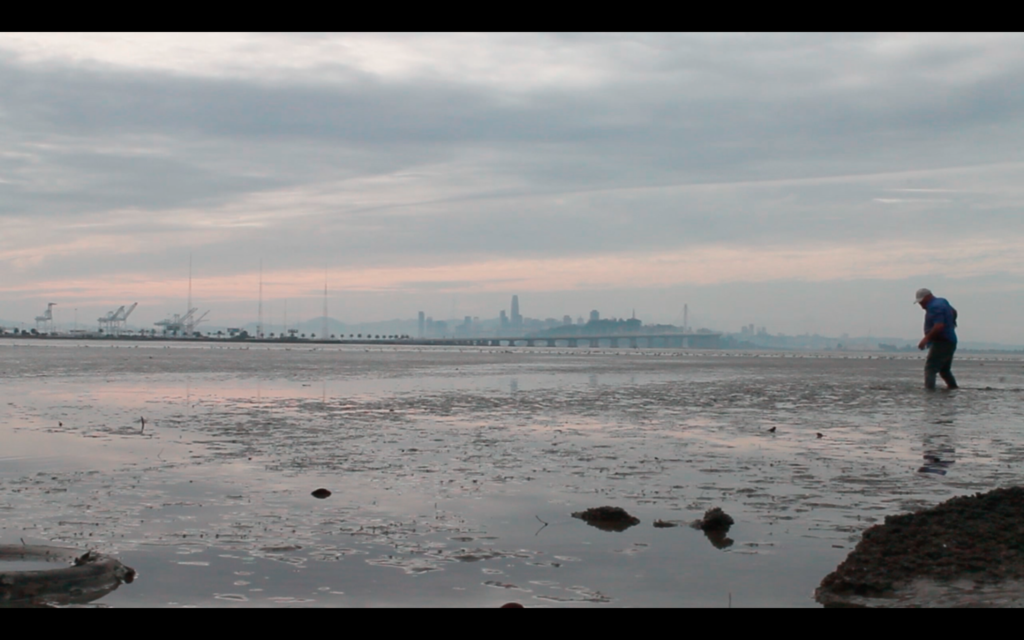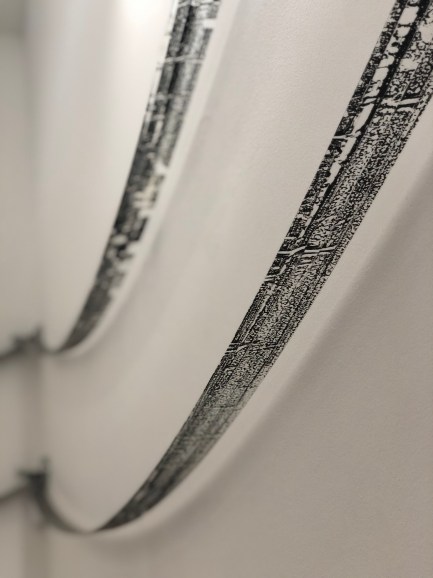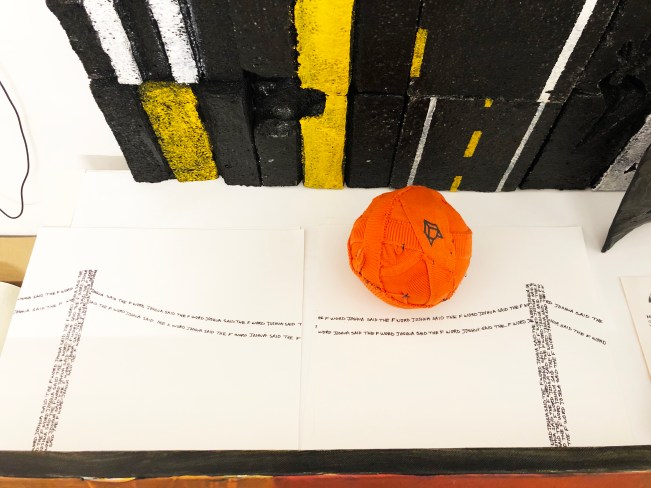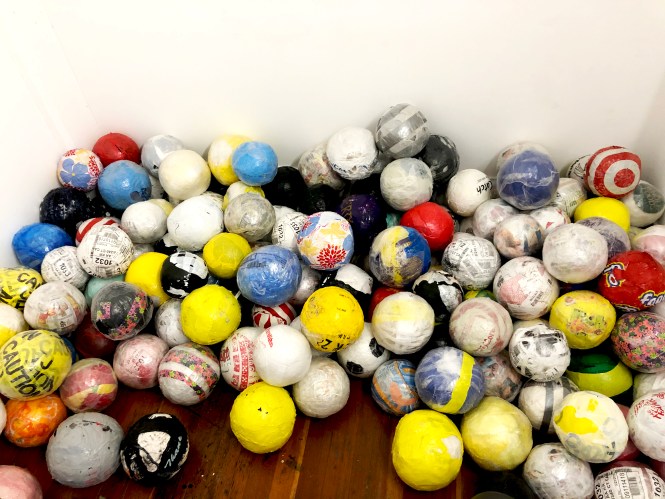
By Alicia McDaniel, Exhibitions Fellow
In conjunction with Root Division’s Reflections on Exile: Evening of Performance, we present Studio Artist Joshua Solis’s rigorous work in our Frank Ratchye Project Space. Solis combines sculpture, video, and performance into a multi-channel installation that showcases the artist’s laborious determination to reclaim nostalgic and traumatic memories from his past.
Solis turns to his interdisciplinary practice to conquer his fears. Not only is this exhibition reflexive of the artist’s bravery and vulnerability, but it is also a testament to his resilience. Solis simultaneously challenges viewers to also confront the trauma from his past and creates an environment for collective healing.
Read more about Solis’s influences, lived experiences, and his work in our interview below.

Alicia McDaniel (Exhibitions Fellow): There is a powerful feeling of disenchantment. Many viewers are familiar with the San Francisco Bay and your video entices them with this gorgeous image of the skyline. However, as the viewer stays with the image you are seen in the foreground struggling to cross the ocean’s polluted shore. This powerful performance reveals the muddy, gritty, and filthy truth about the human-made damage that is being inflicted upon the environment. Can you speak more about this?
Joshua Solis (Studio Artist): In this performance piece, En la tierra de los sueños | In The Land Of The Dreams, 2020, my intentions were to show the viewer a beautiful facade of the Bay Area. The dream city of San Francisco in the background and myself performing in the foreground.
I was hoping to find steadier ground at the site during the low tides that I could walk and perform on. I was anticipating solid ground, as I have a fear of deep waters, however, the shore was far from steady. My legs sank and I found myself struggling to walk against the muddy waters. While this struggle wasn’t intentional it made sense for me to continue anyway as my performance was about ‘Struggle’ and ‘Survival.’ Soon, my perspective of the Bay changed.
The beautiful Bay Area did not seem so beautiful anymore. I still remember the strong smell of oil and rubber and the gross slimy creatures crawling in the polluted waters. Initially, my work was not intended to be environmentalist. I am aware of how the human-made damage is playing a huge role throughout my performance and its strong presence cannot be denied. I feel satisfied with the outcome of my piece. I hope that my work will provide positive conscientiousness to society.
AM: Can you elaborate on the experience you had when you walked through those waters?
JS: I was surprised to find the bay shore in such bad condition. I felt disgusted and worried for my health as I walked in those polluted waters. Mainly, I felt angry and worried about what we have done and are doing to the Bay Area and to our Planet.
AM: Your work is often informed by your lived experiences which takes a significant amount of bravery and vulnerability. Was this body of work inspired by a specific memory or event? Do you see your work as self-portraiture or as extensions of yourself?

JS: This body of work is a compilation of brief past memories and current experiences of struggle and survival. I see my work as extensions of myself. My work is part of me. It gives me a stronger voice and allows me to make greater impact to a much larger and broader audience.
AM: Traveling and displacement appear to also be very personal themes within your work. You once told me that your materials play upon the tension of what defines a home can you expand upon this statement?
JS: Home has always seemed far away from me. In Mexico, my home is the US, and in the US, Mexico is my home. Through finding these materials that trigger memories of my past, I feel I am recovering a piece of ‘Home.’
AM: Is there an element of humor within your diptych video installation of the toilet flushing in juxtaposition to the car traveling through the tunnel? If so, is there a relation to healing from past trauma?
JS: In Mexico, countless times I heard people say: “se vive mejor en el otro lado (one lives better on the other side),” “del otro lado hay muchas oportunidades (there is more opportunities on the other side),” “en los Estados Unidos se gana muchos dolares (one makes big bucks in the US),” “en el Norte los sueños se hacen realidad (dreams come true in North America),” etc.
From my perspective, being a kid who was dealing with constant migration between the US and Mexico, going to “El otro lado (the other side),” didn’t matter. It made no difference whether I stayed in Mexico or in the US, either way it meant saying goodbye to my loved ones and having to deal with new bullies again and again. “Del Otro Lado..|..Dreams Come True,” 2020, is a response to those echoed voices of people of my past, dreaming with “El otro lado.” The flushing toilet adds some humor and a sense of playfulness, highlighting some of my fun childhood memories: flushing paper boats down the toilet or like sticking my head in it. The process I go through before a finished piece (thinking, research, searching, collecting, writing, etc.), provides me with a sense of healing and acceptance.

AM: How did you first begin utilizing vhs tapes as a material?
JS: Many times, my two older brothers and I were left in Mexico apart from our parents. In 1991, unlike other years, my parents had bought enough VHS movies for us to enjoy our stay at “Home.” Since then, I became obsessed with buying VHS movies. I collected over a thousand. Now, that VHS movies are obsolete, my wife insisted it was time for me to get rid of them. At first, I refused to do so, since I was so attached to my collection, but then, it just made sense to use the tapes as an art material.
AM: How has your work changed within your time being a RD Studio Artist?
JS: Although it is hard for me to say that my works have changed within my time being a Root Division Studio Artist, being exposed to so many awesome art exhibitions and surrounded with such extraordinary Bay Area artists has influencing my process. My time at Root Division has inspired, stimulated, and increased my need for labor intensive art making.
AM: Do you have any upcoming shows or projects that you would like mentioned?
JS: Yes, I am in the group exhibition Through My Eyes at the NIAD Art Center’s galleries on 551 23rd Street in Richmond on view from February 1-20, 2020.
The opening reception is Saturday, February 8 from 1:00 to 4:00 pm, with a DJ set from Wayne Smith. The gallery is also hosting a Thirsty Thursday event on Thursday, February 20 from 4:00 to 7:00 pm.
